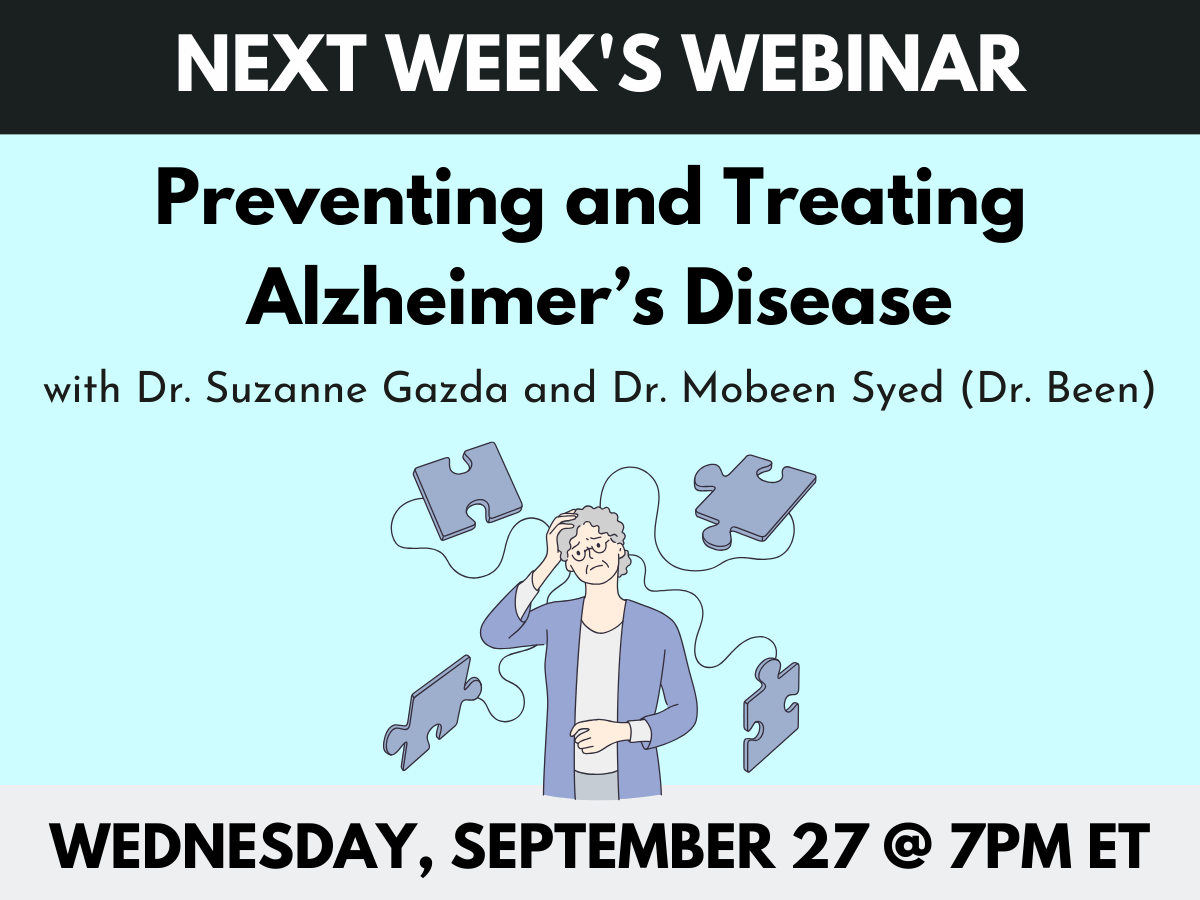The Rising Tide of Long Goodbyes
It's never too early or too late to take action to reduce the likelihood of developing dementia.
Guest post by Dr. Suzanne Gazda
You probably know someone who has Alzheimer’s disease. More than 55 million people around the world are living with dementia at this very moment. Every three seconds, someone else develops the disease.
Alzheimer’s is a devastating neurodegenerative condition. It is a growing global health crisis with profound implications for individuals, their families, and society at large.
September 21, 2023 is World Alzheimer’s Day, a day on which to recognize this life-stealing epidemic that claims more lives than breast cancer and prostate cancer combined: 1 in 3 seniors dies with Alzheimer’s or another form of dementia. Let’s take a moment today to remember them.
Alzheimer's Disease International estimates that the number of people living with dementia will almost triple by 2050 – to 139 million. There is a looming question, as well, about the effect that COVID and its countermeasures will have on rising Alzheimer’s cases. As I wrote a year ago, data show that up to 70% of patients with long COVID and post-vaccine syndrome/“long vax” show signs of cognitive impairment.
Dementia is not inevitable
A majority of people, almost 80%, worry about developing dementia and 1 in 4 people think there is nothing we can do to prevent it. Even most healthcare professionals - 62% globally - wrongly think that dementia is part of normal aging.
It’s not.
The truth is, it is never too early or too late to be proactive about taking steps to reduce the risk of dementia. This starts by understanding and then avoiding risk factors such as head injury, stress, environmental toxins, excessive alcohol consumption, smoking, overweight and obesity, physical inactivity, and infrequent social contact.
Without going into all the details, another risk reduction technique would be to avoid spike protein — whether by COVID infection or injection. The FLCCC has prevention and treatment strategies to stop infection, treat COVID illness, and to clear the body of spike protein.
Dr. Mobeen Syed, Dr. Paul Marik, and I will discuss the impacts of intermittent fasting on Alzheimer’s disease and other things we all should be doing to optimize brain health in an upcoming FLCCC Weekly Webinar on Wednesday, September 27. Register here to join that discussion: https://geni.us/register-for-webinars






Any conversation of Alzheimer’s should involve Dale Bredesen.
He’s the guy who actually SOLVED the problem.
Anyone who really wants to reduce Alzheimer's disease, Parkinson's disease, Multiple System Atrophy, dementia with Lewy bodies and other forms of dementia would sooner or later think of nutrition and vitamin D and do a quick Google Scholar search on "vitamin D" and "dementia", "Alzheimer's disease" or whatever.
Here https://vitamindstopscovid.info/00-evi/#3.3 are a few of the many articles they would find, which show that most, and perhaps all forms of age-related neurodegeneration generally only occur in people with even lower 25-hydroxyvitamin D levels than the lousy levels of the general population, who have only 1/4 to 1/2 of the 50 ng/mL 125 nmol/L circulating 25-hydroxyvitamin D their immune system needs to function properly, including reducing the risk of excessive inflammatory responses.
I have not yet updated the section https://vitamindstopscovid.info/00-evi/#sjw-updated-ratios on how much vitamin D to take to accord with Prof. Wimalawansa's recently simplified ranges of ratios, which he presented in a recent FLCCC webinar 56:26 at: https://covid19criticalcare.com/understanding-vitamin-d/ . This is a simplification of the ranges of ratios he recommended in: "Rapidly Increasing Serum 25(OH)D Boosts the Immune System, against Infections - Sepsis and COVID-19" Nutrients 2022-07-21: https://www.mdpi.com/2072-6643/14/14/2997.
His recommended vitamin D3 daily average supplemental intake quantities, as ranges of ratios of body weight:
70 to 90 IU / kg BW for those not suffering from obesity (BMI < 30).
100 to 130 IU / kg BW for obesity I & II (BMI 30 to 39).
140 to 180 IU / kg BW for obesity III (BMI > 39).
For 70 kg 154 lb without obesity, 0.125 mg (5000 IU) a day is a good amount. This is a gram every 22 years, and pharma-grade vitamin D3 costs about USD$2.50 a gram ex-factory. Higher ratios of body weight are required for those suffering from obesity, since this reduces the ability of the liver to hydroxylate vitamin D3 to 25-hydroxyvitamin D and because excess adipose tissue tends to absorb both vitamin D3 and 25-hydroxyvitamin D: https://vitamindstopscovid.info/00-evi/#obesity-deficit .
If everyone followed Prof. Wimalawansa's recommendation, almost everyone's 25-hydroxyvitamin D would be at least the 50 ng/mL 125 nmol/L their immune system needs to function properly. With no vitamin D3 supplementation, and no recent summertime UV-B skin exposure, most people have only 1/10 to 1/2 of the 25-hydroxyvitamin D they need to be healthy. Government recommended vitamin D3 daily supplemental intake quantities, such as 0.02 mg (800 IU), help somewhat, but are a fraction of what people need for proper immune system function.
If everyone did this, there would be no pandemic influenza or COVID-19 - and sepsis (11 million deaths worldwide in 2017, https://www.thelancet.com/journals/lancet/article/PIIS0140-6736(19)32989-7/) would be rare. Likewise dementia, Kawasaki disease and MIS-C.